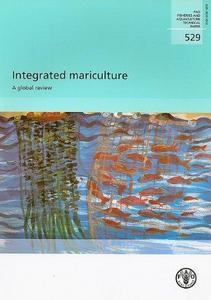
Integrated Mariculture : A Global Review
While the concept and practice of integrated aquaculture is well-known in inland environments particularly in Asia, in the marine environment, it has been much less reported. However, in recent years the idea of integrated aquaculture has been often considered a mitigation approach against the excess nutrients/organic matter generated by intensive aquaculture activities particularly in marine waters. In this context, integrated multitrophic aquaculture (IMTA) has emerged, where multitrophic refers to the explicit incorporation of species from different trophic positions or nutritional levels in the same system. Integrated marine aquaculture can cover a diverse range of co-culture/ farming practices, including IMTA, and even more specialized forms of integration such as mangrove planting with aquaculture, called aquasilviculture. Integrated mariculture has many benefits, among which bioremediation is one of the most relevant, and yet is not valued in its real social and economic potential although the present document provides some initial economic estimates for the integration benefits derived from bioremediation. Reducing risks is also an advantage and profitable aspect of farming multiple species in marine environments (as in freshwaters): a diversified product portfolio increases the resilience of the operation, for instance when facing changing prices for one of the farmed species or the accidental catastrophic destruction of a crop. Yet such perspectives are far from being considered in mariculture where, on the contrary, there is a tendency to monoculture. Modern integrated mariculture systems must be developed in order to assist sustainable expansion of the sector in coastal and marine ecosystems thus responding to the global increase for seafood demand but with a new paradigm of more efficient food production systems. Successful integrated mariculture operations must consider all relevant stakeholders into its development plan government, industry, academia, the general public and non-governmental organizations must work together and the role of integrated mariculture within integrated coastal zone management plans must be clearly defined. There is a need to facilitate commercialization and promote effective legislation for the support and inclusion of integrated mariculture through adequate incentives particularly considering the reduction of environmental costs associated to monoculture farming. Bioremediation of fed aquaculture impacts through integrated aquaculture is a core benefit but the increase of production, more diverse and secure business, and larger profits should not be underestimated as additional advantages. In many cases, more research is needed to further integrated mariculture - particularly regarding the technical implementation of a farm. At this level, an important issue is to adopt adequate management practices that avoid or reduce the likelihood of disease transmission within and between aquaculture facilities or to the natural aquatic fauna. Also, careful consideration should be paid to the selection of species used in polyculture or integrated multitrophic aquaculture to reduce potential stress and suffering of culture individuals. Integrated aquaculture should be looked upon as a very important tool to facilitate the growth of marine aquaculture and promote sustainable development. Source: OpenLibrary
In your inventory
In your friends' and groups' inventories
Nearby
Elsewhere
Edition - isbn:9789251063873 - inv:1732d81bf7376e04da27568a7773a3aa